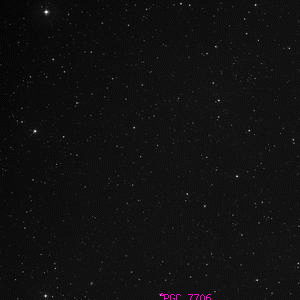IC 188

Overlaid DSS image of IC 188, 60' x 60' with north at top and west to the right
Aladin viewer for the region around IC 188
| Type | Unknown |
|---|---|
| Magnitude | Right Ascension | 2h 1' 57.6" (2000) |
| Declination | 27° 1' 43" N |
| Constellation | Triangulum |
| Classification | eeF, vS, R |
Observing Notes
Harold Corwin
Though large errors exist in Swift's places for these two galaxies [IC 187 and IC 188], they could have been seen by him, and the descriptions are not inconsistent.
Courtney Seligman
Per Dreyer, IC 188 (Swift list IX (#8), 1860 RA 01 54 01, NPD 63 39.0) is "most extremely faint, very small, round". The position precesses to RA 02 01 57.6, Dec +27 01 43, whence the position above, but there is nothing there, or anywhere near there.
However, Corwin lists a galaxy half a degree to the south (PGC 7706) as the IC object, and since he is a well-respected authority in the field several databases (including the NED) have accepted that identification. The argument in favor of PGC 7706 is that half-degree errors, though rare, have been shown to occur in the NGC/IC, and as Corwin notes (referring to IC 187 and 188), "Though large errors exist in Swift's places for these two galaxies, they could have been seen by him, and the descriptions are not inconsistent." And it is possible that two 13th-magnitude stars well to the north-northwest of PGC 7706 are what Lewis Swift's Catalogue No. 9 (which credits his son Edward with the discovery) referred to in stating that "2 stars point to it".
The argument against PGC 7706 is that although half-degree errors have been shown to occur, they should only be accepted when the description of the object is unequivocal. Swift's description could be applied to PGC 7706, but it could just as easily be applied to a completely nonexistent object, as it puts the "most extremely faint" object at or beyond the limits of his ability to reliably see anything at all. The note about two stars pointing at it does not convincingly apply to the stars to PGC 7706's north-northwest, as they are further from the galaxy than is normally the case in such descriptions, and if you go far enough afield it is easy to find a pair of stars that align with almost any object simply by random chance.
Perhaps most telling, as pointed out by Thomson, is that Swift makes no mention of the relative positions of IC 187 and 188. In other cases of two nebulae found in the same region on the same night Swift invariably states that each is "one of 2" preceding or following the other, along with an indication of their relative positions. In this case neither entry mentions the other, suggesting that they were not in the same region.
But on the night in question, as noted in Catalogue No. 9, Edward was searching for "Swift's Comet", one of several discovered by his father, and was using a wide-field objective that would have shown both objects in the same field of view if they were as close together as PGC 7706 and IC 187. Under these circumstances, although it is possible that PGC 7706 is IC 188, it seems more likely that the IC entry refers to a nonexistent object, hence my choice to describe it as such. But as in all cases where some controversy exists about the identification of an NGC/IC object, I have provided an entry for PGC 7706 immediately following this one.
Other Data Sources for IC 188
Nearby objects for IC 188
12 objects found within 120'
| 10 Arietis | 11 Arietis | 14 Arietis |
| IC 1752 | IC 1753 | IC 187 |
| NGC 780 | NGC 784 | NGC 805 |
| NGC 807 | PGC 2800932 | PGC 7706 |
Credits...
Drawings, descriptions, and CCD photos are copyright Andrew Cooper unless otherwise noted, no usage without permission.
A complete list of credits and sources can be found on the about page
IC 188